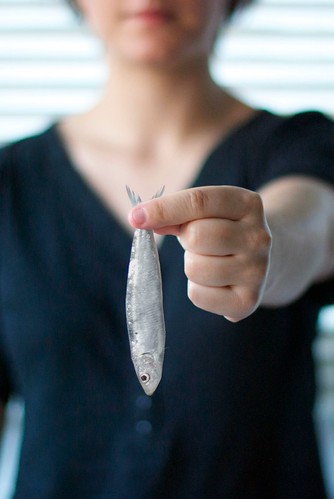Tachán... el primer ingrediente: SARDINAS

Mes de vacaciones, mes de veranito, sol ☀ y playa... mes de cumpleaños de una de las cocineras! (que ya tiene las mejillas hinchadas para soplar velitas). Mes para disfrutar del mar. Y entre todos sus exquisitos manjares hemos seleccionado este pescado azul de pequeñas dimensiones.
Las sardinas (Sardina pilchardus) habitan en aguas del Mar Mediterráneo y en el Océano Atlántico. Suelen medir unos 11-30cm de longitud y pesan entre 50-200g. Su nombre tiene origen en la "Costa de la Sardina" en la isla mediterránea de Cerdeña dónde habitaban en gran cantidad. Y la temporada de pesca es de mayo a octubre.
Hay otras tipos y especies similares que habitan en aguas del Mediterráneo (Alacha, Sábalo), en el Atlántico (Arenque), en los Mares del Norte de Europa (Espadín) o hasta en el Pacífico (Sardina Española).
Tiene un estupendo sabor pero una delicada conservación, por lo que es importante consumirla rápido cuándo es fresca.
A la población en general, se le recomienda el consumo de pescado, preferiblemente azul, al menos dos veces por semana, para asegurar un aporte adecuado de ácidos grasos omega 3. Por lo que la sardina, es una buena opción. Además, es una excelente fuente de calcio siempre y cuándo se consuma con la espina. En el caso de la sardina enlatada el aporte de calcio puede llegar a ser cinco veces mayor que en la fresca, debido al tratamiento térmico en el momento de enlatar.
Os invitamos a preparar deliciosas recetas y a mandarnos las fotos de vuestros platos con las sardinas como ingrediente principal antes del 31 de agosto. Nosotras ya empezamos a preparar las nuestras, qué será, qué será...
Las Cocineras
----------------------------------------------------------------------------------------------------------
Ta-dah... the first ingredient: SARDINES
August is a holiday month, a summer month, filled with sunshine ☀ and beach days... it's also the birthday month of one of the chefs! (and she already has her wee cheeks filled with air to blow those candles).
August is also a month to enjoy the sea and what the sea gives us. Amongst all the exquisite seafood options, we have selected a small oily fish species, the sardine, as it is a seasonal food of mediterranean Europe.
The Chefs
Ta-dah... the first ingredient: SARDINES
August is a holiday month, a summer month, filled with sunshine ☀ and beach days... it's also the birthday month of one of the chefs! (and she already has her wee cheeks filled with air to blow those candles).
August is also a month to enjoy the sea and what the sea gives us. Amongst all the exquisite seafood options, we have selected a small oily fish species, the sardine, as it is a seasonal food of mediterranean Europe.
Sardines (Sardina pilchardus) live in the Mediterranean sea and the Atlantic Ocean. They're about 11-30cm long and weigh between 50-200g. The species name finds its origin in the Sardinian Coast, where sardines were quite abundant once upon a time. The fishing season is between May and October (hence the seasonal!).
There are other similar species to the sardine which live in the Mediterranean sea (sardinella, shad), in the Atlantic Ocean (herring), in the North Sea and even in the Pacific (Spanish sardine).
Sardines are incredibly yummy but are very delicate to keep, so it's quite important to eat it soon after fishing it, while still fresh.
It is recommended to eat at least two fish meals a week, as it is an excellent source of omega-3 fatty acids. Sardines in particular are a great source of these acids. In addition, sardines are a very good source of calcium when one eats the bones! Interestingly, tinned sardines can have up to five times the amount of calcium of fresh sardines, due to the thermal treatment used during the tinning process.
Know enough about sardines? How about we get cracking with some recipes then?
We'd like to invite you to prepare (preferably) delicious recipes with sardines as the main ingredient and send us photos of your (gourmet) dish before the 31st of August.
We are already working on our recipe... what could it be?
There are other similar species to the sardine which live in the Mediterranean sea (sardinella, shad), in the Atlantic Ocean (herring), in the North Sea and even in the Pacific (Spanish sardine).
Sardines are incredibly yummy but are very delicate to keep, so it's quite important to eat it soon after fishing it, while still fresh.
It is recommended to eat at least two fish meals a week, as it is an excellent source of omega-3 fatty acids. Sardines in particular are a great source of these acids. In addition, sardines are a very good source of calcium when one eats the bones! Interestingly, tinned sardines can have up to five times the amount of calcium of fresh sardines, due to the thermal treatment used during the tinning process.
Know enough about sardines? How about we get cracking with some recipes then?
We'd like to invite you to prepare (preferably) delicious recipes with sardines as the main ingredient and send us photos of your (gourmet) dish before the 31st of August.
We are already working on our recipe... what could it be?
The Chefs
Fuentes / Sources:
FAO: ftp://ftp.fao.org/docrep/fao/009/ac482e/AC482E11.pdf
Pescaderías Coruñesas: http://www.pescaderiascorunesas.es/productos/ficha/?id=76
Base de datos de alimentos: http://www.seh-lelha.org/busalimento.aspx
Artículo revista Nutrición Clínica y Dietética Hospitalaria "Omega 3 y enfermedad cardiovascular: más allá de los factores de riesgo": http://www.nutricion.org/publicaciones/revistas/Revisión_Omega-3_2009_1.pdf

No hay comentarios:
Publicar un comentario